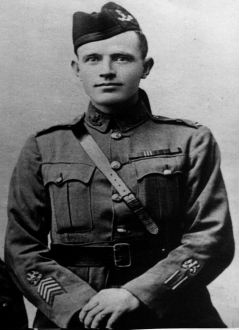

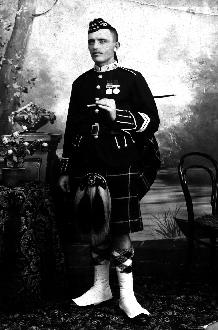
In 1900 at the age of 19 he joined the 2nd Battalion of the Seaforth Highlanders in Glasgow, Scotland. He spent 12 years with the Seaforths and served 8 years abroad in Egypt, India, Somaliland and fought in South Africa in the Boer War. During this time he received the Queen's South Africa Medal (Somaliland) and the Africa General Service Medal (Boer War)
He moved to Winnipeg, Manitoba, Canada about 1909 and was one of the first to join the 79th Cameron Highlanders of Canada when the militia formed in 1910.
In 1911 he was among the Special Coronation Company who visited the Queen's Own Cameron Highlanders (Imperial Army) at Aldershot, England and attended the ceremonies in connection with the coronation of His Majesty King George the Fifth on June 22, 1911.
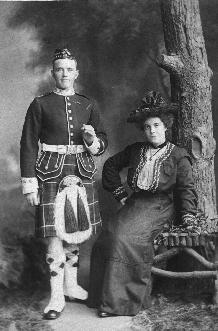
On Nov 23, 1911 James Kay married Annie Amelia Clark of Tranmere, Cheshire, England. They had a small ceremony at Point Douglas Presbyterian Church in Winnipeg, Manitoba, Canada.
On July 9, 1912 they were blessed with their first child whom they named Annie Patricia Kay.
In 1914 at the breakout
of WW1 he immediately enlisted (even though his wife was pregnant with
her second child) and became company sergeant-major of the No 4 Company
of the 16th Battalion (Canadian Scottish) Canadian Expeditionary Force,
3rd Brigade, First Canadian Division. They proceeded to Valcartier camp
Aug. 23, 1914 and on Sept. 30, 1914 left Quebec for England. They spent
the winter of 1914-1915 at Salisbury Plain and arrived in France Feb. 15,
1915.
His second letter dated Dec. 10, 1914 he was at Larkhill on Salisbury Plain in England. He still has not heard about the birth of the baby.
His third letter dated Jan. 22, 1915 expresses his joy at his daughter's arrival on Nov.24, 1914 and with his wife for naming the baby Doris Cameron Kay in honor of his regiment.
His next communication was a form postcard dated March 29, 1915 in which the soldiers were not allowed to add anything except the date and a signature.
His next letter is written from Belgium on July 15, 1915. He has just come out of the trenches in Belgium and has received a promotion to Regimental Sergeant Major due to the previous RSM (Dave Nelson) being wounded and sent back.
On Aug. 24, 1915 he writes after just having had a short 2 day leave at home in Elgin (a little hungover by the sound of it!)
In March 1916 he was
awarded the Distinguished
Conduct Medal. The citation reads
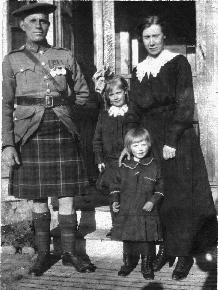
Jame Kay served continuously at the front from February, 1915, until early in 1918, when he was sent back to Canada, on the three months leave of absence granted to married men of the 1st Canadian Division. He was finally able to see his new daughter and luckily there are a few pictures of him with his wife and two children together.
He was offered a commission several times but he turned them down. He was also offered inducements to accept Staff positions in Winnipeg, Manitoba, Canada but he refused saying that his place was at the front where he was needed most.
He returned to the trenches of France in Aug. 1918 with his arm in a sling.
The Armistice Day, November 11, 1918 did not bring an immediate end to army maneuvers. The company was on the western outskirts of Mons and they paraded through the town full of welcoming inhabitants who saw them as the final sign of freedom and final victory.
On Dec. 13, 1918 they marched into Germany and crossed the Rhine. They were quartered in the locality of Cologne until Jan. 5, 1919.
The next letter from Germany is dated Dec. 28, 1918 and he has just had his quietest Xmas ever. Soldiers are starting to come back to Canada. He is glad to be missing the cold Winnipeg weather but he says he is looking forward to coming home in the near future.
Still in Germany a few days later, Jan. 2, 1919 he writes home to say that he was wounded in Cambrai and was given the Military Medal for it and had now heard he will get the Military Cross as well. At the end of it he says "no more wars for me".
The two medals were awarded for his actions during the last major battle of the war at Cullivers. The Battalion was in a critical situation - under machine gun fire and in danger of being surrounded. A strong counter attack was threatened; the amunition situation was desparate. RSM James Kay moved up and down amongst the men encouraging them and ordering them to reserve their ammunition until the enemy came close up before firing and then attacking with bayonets.
Captain R.S.Robertson is quoted as saying "The effect of Kay's cool, determined leadership was most inspiring."
Jan 5, 1919 they left Germany for Belgium where they remained in Anthiet, a village some 30 kilometres from Brussels. The first impression was "A 'ell' of a 'ole, everything mud, Belgium at it's worst." But the first impressions proved wrong and one man of the 16th is quoted as saying that it was a glorious and grand feeling and that their stay there was one never to be forgotten.
By Feb. 1, 1919 he has had enough of the war and talks of what his life will be like when he gets home and tells his wife to prepare for lots of visitors as many war buddies may stay with them. They are 6 weeks away from leaving for home. Although he has had enough of the war he says he will still remain with the company "until the next war". He also had the honour of leading the company in a parade as Brigade Sergeant Major as he was the oldest member in France at the time.
His last letter dated
Feb. 15, 1919 brings
about a sad and unexpected end to a remarkable career and man. He is in
the town of Anthiet, Belgium and has been sickened by influenza.
His letter reveals his illness but not the severity of it and he tells
his wife they are leaving in 3 days time to head down the line and still
hope to be in Canada by April.
James Kay was described
as being of pleasant expression, good natured, possesed of a store of common
sense. He was, in his average, firm build, the British soldier of the "old"
army, as that fighting man is usually pictured. He was a loyal comrade,
a capable non commissioned officer, fair and humane, but without any show
of weakness in his handling of men. He was a soldier of long experience
and tried worth who could truly be said died at the post of duty.
Annie Kay's next letter came from the Officer in Command of the 16th Battalion on Feb 20th, 1919 informing her of James death. Condolences were sent by the mayor of Anthiet who vowed to take care of the cemetery plot donated by the town for him. "It will always be covered with flowers". The family who cared for James just before his death also wrote with details of his death talking about how he refused to stay in bed and insisted on parading.
Annie Kay never remarried and on May 8, 1935 she was given the honour of unveiling a cross, which was brought from the battle field at Arras, honouring the men of the 16th Canadian Scottish who died there. The cross stands on the grounds of the First Presbyterian Church in Winnipeg, Manitoba.
Annie Kay died in Winnipeg, Manitoba in 1976 at the age of 84.
R.S.M. James Kay M.C.,D.C.M.,
M.M., M.I.D. medals and a few of his army artifacts have been donated to
the Cameron Highlander Museum at Minto Barracks, Winnipeg, Manitoba.
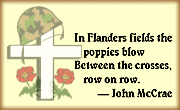
 Home
Home